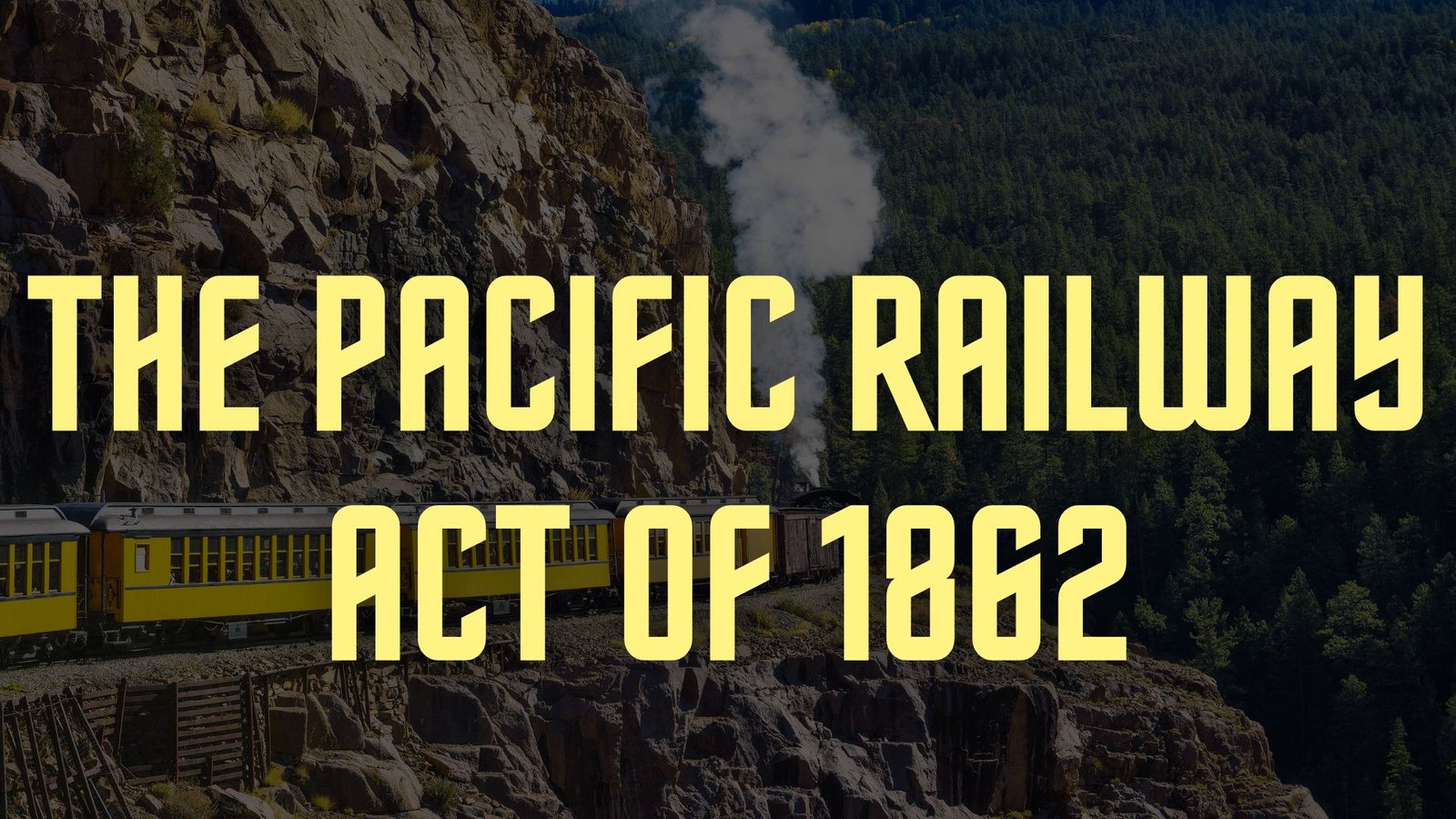On this page you will read detailed information about The Pacific Railway Act of 1862.
As you read about the Pacific Railway Act of 1862, consider the monumental undertaking of building the first transcontinental railroad across the United States. This legislation authorized the Central Pacific and Union Pacific railroad companies to construct a continuous railroad line westward from the Missouri River to the Pacific coast. The Pacific Railway Act provided federal incentives for the private companies in the form of land grants and loans to subsidize the enormous costs. The construction of the transcontinental railroad transformed commerce and travel in 19th century America by connecting the East and West coasts with a fast, reliable overland route. This ambitious project demonstrated the potential of industry and technology to conquer the challenges of geography and environment. The history of the transcontinental railroad provides valuable insights into the economic motivations, engineering feats, and political controversies involved in this defining enterprise of its era.
The Need for a Transcontinental Railroad
The vast expanse of the American West remained largely unsettled in the mid-19th century. Travel across the country was difficult and treacherous, taking months to complete.
Connecting the coasts
A transcontinental railroad was necessary to connect the established cities of the East to the frontier in the West. By linking the Atlantic and Pacific Oceans, a railroad could transport people and goods across the country in a matter of days rather than months. This connectivity was crucial for enabling travel, trade, and communication across this massive region.
Economic opportunity
A transcontinental railroad also promised substantial economic benefits. It would open up the West to new markets and commerce, spurring growth and development. New towns would spring up along the railroad, creating demand for goods and services. The railroad would make it possible to transport raw materials and agricultural products from the West to factories and population centers in the East. The government hoped this would drive further western expansion and settlement.
Political motivations
There were also political motivations for constructing a transcontinental railroad. Some leaders believed that a railroad was necessary to strengthen the unity of the country after the Civil War. It would tie the nation together from coast to coast, both symbolically and physically. There were also concerns about foreign powers gaining control over western lands. A transcontinental railroad was seen as crucial for solidifying U.S. sovereignty over these territories.
Overcoming challenges
Constructing a transcontinental railroad posed enormous challenges, both technological and financial. The route crossed vast, undeveloped land, towering mountains, and harsh terrain. But visionary leaders and burgeoning railroad companies were determined to make this ambitious plan a reality. The Pacific Railway Act of 1862 provided government support to help the Central Pacific and Union Pacific railroads achieve this monumental feat of engineering.
In the previous post, we had shared information about Understanding the Jones Act: A Legal Analysis, so read that post also
Key Provisions of the Pacific Railway Act
The Pacific Railway Act of 1862 authorized the construction of the first transcontinental railroad across the western United States. It provided federal subsidies in the form of land grants and loans to the Union Pacific Railroad and Central Pacific Railroad companies to build the railroad.
Land Grants
The Act granted the railroads 10 square miles of land for every mile of track built. The land was distributed in a checkerboard pattern, with the railroads receiving odd-numbered lots. The railroads could then sell this land to settlers and use the proceeds to finance construction. This provision gave the railroads a strong incentive to build quickly to gain more land.
Loans and Bonds
The Act also authorized the U.S. government to issue 30-year bonds at 6% interest to the railroad companies. For every mile of track built, the railroads would receive bonds that they could then sell to raise funds. The railroads were required to pay back the loans, but the U.S. government would retain the first mortgage on the railroads until the loans were repaid.
Completion Deadlines
To ensure steady progress, the Act set specific deadlines for completing sections of track. For example, the Union Pacific was required to build 100 miles of track in the first two years, and 50 miles each subsequent year. If a railroad failed to meet a deadline, it would forfeit its land grants and loans. This provision encouraged rapid construction of the transcontinental route.
Connecting the Railroads
The Act stipulated that the Central Pacific would start building east from Sacramento, California, while the Union Pacific would start building west from Omaha, Nebraska. The railroads were required to connect their tracks and form a continuous route across the country. When they met at Promontory Summit, Utah on May 10, 1869, the first transcontinental railroad was complete, revolutionizing transportation and commerce in the United States.
The Pacific Railway Act of 1862 successfully spurred the construction of the first transcontinental railroad by providing the necessary federal funding and incentives to make the project commercially viable for private railroad companies. The railroad it enabled transformed the American West and connected the country from coast to coast.
Government Subsidies and Land Grants
The Pacific Railway Act of 1862 provided government subsidies and land grants to the Central Pacific and Union Pacific Railroad companies to construct a transcontinental railroad across the Western United States.
Loans and Bonds
The federal government issued 30-year government bonds at 6 percent interest to the railroad companies. For each mile of track laid, the government loaned $16,000 to the Central Pacific and $48,000 to the Union Pacific. The bonds provided the necessary capital to commence construction and the companies were not required to repay the principal until the bonds matured 30 years later.
Land Grants
In addition to the government bonds, the companies received 400-foot right-of-ways and sections of land along the rail route. The government granted the companies alternate sections of public land for 10 miles on either side of the right-of-way. This amounted to 12,800 acres of land for every mile of track. The railroad companies could then sell or develop this land to generate additional revenue. These generous land grants gave the railroads a strong incentive to build quickly in order to gain control of as much land as possible.
Oversight and Restrictions
To ensure progress on the transcontinental railroad, the Act established several provisions for government oversight and placed restrictions on the railroad companies. The companies had to complete sections of 100 miles of track before receiving the land grants and bond subsidies for that section. The gauge, or width between the rails, had to be standardized to 4 feet 8 1⁄2 inches. Finally, the railroad had to be completed by 1876 or risk forfeiting the land grants and bond subsidies.
The Pacific Railway Act’s subsidies and land grants provided the necessary means and motivation for the Central Pacific and Union Pacific to undertake the immense challenge of constructing a transcontinental railroad across the Western frontier. The generous terms and the desire to gain control of land led the companies to build rapidly, forever changing the settlement of the American West.
The Central Pacific and Union Pacific Railroads
The Central Pacific Railroad Company and Union Pacific Railroad Company were responsible for constructing the western and eastern portions of the First Transcontinental Railroad, respectively.
The Central Pacific Railroad
The Central Pacific Railroad was in charge of building the western portion of the transcontinental railroad, starting in Sacramento, California. They hired many Chinese immigrants to help construct the challenging route through the Sierra Nevada mountains. Despite facing discrimination and dangerous working conditions, the Chinese laborers played an instrumental role in completing the western section.
The Union Pacific Railroad
The Union Pacific Railroad was responsible for constructing the eastern portion of the transcontinental railroad, starting in Omaha, Nebraska. They relied primarily on Irish immigrants and Civil War veterans to build the railroad. The Union Pacific used innovative tools and techniques to rapidly construct their section, including pre-built track sections and temporary settlements along the route.
A Meeting at Promontory Summit
On May 10, 1869, the Central Pacific and Union Pacific railroads finally met at Promontory Summit, Utah. A golden spike was ceremoniously driven into the final tie to join the two sections, completing the First Transcontinental Railroad. This pivotal moment enabled coast-to-coast travel and commerce across the United States for the first time. The transcontinental railroad transformed transportation, connecting both coasts of the country with a single rail line and reducing cross-country travel time from months to days.
Impact and Legacy
The First Transcontinental Railroad had an enormous impact on the country, boosting the economy and strengthening the unity of the nation after the Civil War. It spurred development of the West, allowing goods and settlers to efficiently travel to the region. The transcontinental railroad also made the US more accessible to immigrants and visitors. This groundbreaking achievement demonstrated the determination, innovation, and teamwork that defined 19th century America. The First Transcontinental Railroad left behind a legacy of overcoming seemingly insurmountable challenges through perseverance and human ingenuity.
Constructing the Transcontinental Railroad
To build the transcontinental railroad, the Central Pacific Railroad Company began construction in Sacramento, California, while the Union Pacific Railroad Company started in Omaha, Nebraska.
Materials and Labor
The Central Pacific relied primarily on Chinese immigrant labor, while the Union Pacific hired Civil War veterans and Irish immigrants. The work was difficult and dangerous, requiring the movement of massive amounts of dirt and rock with pickaxes and shovels.
Overcoming Obstacles
Both companies faced enormous challenges in constructing the railroad over treacherous terrain. The Central Pacific had to blast through the Sierra Nevada mountains, at times progressing only a few inches per day. The Union Pacific crossed the Nebraska plains, ascending more than 8,000 feet in less than 100 miles at one point. Harsh winters also halted progress for months at a time.
Despite the hardships, the railroad companies were motivated by government incentives. For every mile of track laid, the government provided land grants and loans. Competition between the companies also spurred faster construction. At its peak, the Central Pacific was laying an astonishing 10 miles of track per day.
Connecting the Nation
On May 10, 1869, the final spike was driven in Promontory, Utah, connecting the Central Pacific and Union Pacific railroads. The completion of the transcontinental railroad was a pivotal moment in U.S. history that united the country from coast to coast. Goods and people could now travel across the continent in a matter of days, fueling economic growth and shaping America into a single nation. The Pacific Railway Act of 1862, which authorized the railroad, has enduring significance as one of the most important laws passed by the U.S. Congress.
In conclusion, the immense challenges in constructing the transcontinental railroad were overcome through human perseverance, government support, and competition between companies. Its completion transformed the country by connecting East and West, ushering in a new era of unity and prosperity in America.
Completing the Transcontinental Railroad
To complete the transcontinental railroad, the Central Pacific Railroad company began construction in Sacramento, California, building east, while the Union Pacific Railroad company commenced in Omaha, Nebraska, building west. The eventual connection of the rails at Promontory Summit, Utah on May 10, 1869 marked the completion of the transcontinental railroad and enabled coast-to-coast rail travel across America.
Through the Pacific Railway Act of 1862, the U.S. government provided public land grants and subsidies to the Central Pacific and Union Pacific railroads to spur construction. However, actually building the railroad was an immense challenge that required tunneling through mountains, bridging rivers, and moving massive amounts of earth and rock. Construction was dangerous work that cost many lives. Predominantly Chinese workers were employed to build the western portion by the Central Pacific, while Irish workers built the eastern section for the Union Pacific.
The two railroad companies competed fiercely to complete sections as quickly as possible to gain more government incentives, often building hastily and cutting corners. They finally met at Promontory Summit, driving a commemorative golden spike to join the rails while dignitaries looked on. Immediately, the transcontinental railroad revolutionized transportation and connectivity in America. Goods and people could now traverse the continent in a matter of days, stimulating trade and commerce nationwide.
The achievement of the transcontinental railroad was a pivotal moment in U.S. history that shaped the country’s western expansion and growth. Though the endeavor was fraught with challenges, the vision and determination to unite America’s coasts paid off, launching the nation into a new era of industrialization and economic opportunity. The golden spike at Promontory Summit stands as an enduring symbol of this pivotal accomplishment.
Impact and Significance of the Transcontinental Railroad
The completion of the transcontinental railroad in 1869 marked a pivotal moment in American history. By linking the Central Pacific and Union Pacific railroads, the Pacific Railway Act of 1862 enabled coast-to-coast travel and commerce across the United States for the first time. This massive infrastructure project shaped the country in profound ways that still resonate today.
The transcontinental railroad accelerated the settlement of the American West, making it easier for pioneers and homesteaders to migrate from the East. Whole towns sprouted up along the railroad, and many western cities like Denver, Salt Lake City, and Portland flourished as a direct result of being connected to the transcontinental route. The railroad also promoted economic growth by enabling the fast, large-scale transport of goods and raw materials across great distances.
Culturally, the transcontinental railroad tightened connections between Americans across the continent. Traveling from New York to San Francisco now took only a week, allowing for greater mingling of people from diverse regions. The railroad became deeply embedded in American art, music, and literature, symbolizing pioneer spirit, technological innovation, and national unity.
For Native Americans, however, the transcontinental railroad brought violence, displacement, and loss of land. As the railroad expanded westward, the US government forcibly removed tribes from their ancestral territories. The near-extinction of the American bison was also linked to the spread of the railroads, which allowed hunters to gain access to the Great Plains.
Though the Pacific Railway Act of 1862 and the transcontinental railroad yielded both benefits and costs, they left an indelible imprint on the American landscape and psyche. The vision and diligence required to construct this massive infrastructure project have endured as a point of national pride, even as its troubled legacy continues to shape our society today. Overall, the transcontinental railroad stands as a monumental achievement that profoundly transformed the United States in the 19th century and shaped its ascent as a world power.
The Legacy of the Pacific Railway Act
The Pacific Railway Act of 1862 shaped the development of the United States in profound and lasting ways. By authorizing government subsidies and land grants to encourage the construction of the first transcontinental railroad, the act accelerated Western expansion and economic growth.
The transcontinental railroad enabled fast, reliable transportation across the country for the first time. Prior to its completion, the journey from coast to coast was long and treacherous, taking months to traverse undeveloped land and trek over mountains. The railroad cut travel time down to less than a week, allowing for the easy transport of goods and people. This connectivity stimulated commercial trade between the East and West coasts and facilitated further railroad construction.
The government incentives provided by the Pacific Railway Act attracted massive investments in the railroad. Two private companies, the Central Pacific Railroad and Union Pacific Railroad, received huge federal land grants and subsidies to finance construction of the transcontinental line. The project created many jobs and spurred the development of new towns along its route. The completion of the railroad in 1869 was a pivotal moment, symbolizing the country’s pioneering spirit and marking its first major step toward becoming an industrial power.
In addition to shaping the nation’s economy and transportation networks, the Pacific Railway Act impacted Western expansion and Native American tribes. The law set aside lands for homesteading by settlers, fueling migration along the railroad’s path. Tragically, it also led to conflicts over land with Native tribes, contributing to violence against indigenous peoples.
The Pacific Railway Act of 1862 and the first transcontinental railroad it enabled left an indelible imprint on the United States. By revolutionizing transportation, stimulating economic growth, and influencing Western development, this iconic infrastructure project marked a turning point in American history that still resonates today. Its effects, both positive and negative, highlight the law’s complex and consequential legacy.
FAQs About the Pacific Railway Act
The Pacific Railway Act of 1862 was pivotal legislation that enabled the construction of the first transcontinental railroad across the United States. As with any ambitious infrastructure project, the Act raised many questions that citizens and lawmakers grappled with at the time.
The federal government provided subsidies in the form of land grants and loans to the Union Pacific Railroad and Central Pacific Railroad companies to finance construction. For every mile of track laid, the railroads received land grants and government bonds they could sell to raise funds. The arrangement transferred the financial risk from private investors to taxpayers.
The Act granted the railroads rights-of-way through public lands, inevitably crossing Native territories. The railroads negotiated treaties with tribes to acquire lands, often through coercion and for far less than fair market value. The dispossession and violence toward Native peoples during construction was a tragic consequence of the Act.
Building a transcontinental railroad posed enormous engineering challenges that many thought impossible. Steep mountain ranges, harsh weather, and long distances made construction difficult. New equipment, explosives, and construction techniques were developed to conquer the challenges. The feat was a testament to the ambition, ingenuity, and sacrifice of the workers who built the railroad.
The transcontinental railroad revolutionized travel and commerce in the U.S. Goods and people could cross the continent in a week versus the months required before. The railroad stimulated the economy, fostered new settlements, and connected markets across the country. It was a seminal achievement that demonstrated the power of new technological innovations and America’s pioneering spirit in the 19th century.
Overall, the Pacific Railway Act was a consequential yet complex piece of legislation that shaped the American West. While it enabled a historic achievement, it also reflected the political controversies and social inequities of the era. The railroad’s impact resonates to this day, for better and for worse.
Conclusion
As you have seen, the Pacific Railway Act of 1862 was a pivotal moment in American history that bound the nation together in the aftermath of the Civil War. The ambitious project to build a transcontinental railroad was fraught with challenges, yet through perseverance and ingenuity, it succeeded in linking the East and West coasts with bands of iron. The completion of the railroad opened up opportunities for commerce, migration, and economic development across the continent. Its legacy lives on in the infrastructure that continues to connect people and places across America today. When reflecting on this grand undertaking that tested the mettle of a divided nation, you cannot help but admire the vision, courage and sacrifice that built this vital artery of American life.
Disclaimer
The information and services on this website are not intended to and shall not be used as legal advice. You should consult a Legal Professional for any legal or solicited advice. While we have good faith and our own independent research to every information listed on the website and do our best to ensure that the data provided is accurate. However, we do not guarantee the information provided is accurate and make no representation or warranty of any kind, express or implied, regarding the accuracy, adequacy, validity, reliability, availability, or completeness of any information on the Site. UNDER NO CIRCUMSTANCES SHALL WE HAVE ANY LIABILITY TO YOU FOR ANY LOSS OR DAMAGE OF ANY KIND INCURRED AS A RESULT OR RELIANCE ON ANY INFORMATION PROVIDED ON THE SITE. YOUR USE OF THE SITE AND YOUR RELIANCE ON ANY INFORMATION ON THE SITE IS SOLELY AT YOUR OWN RISK. Comments on this website are the sole responsibility of their writers so the accuracy, completeness, veracity, honesty, factuality and politeness of comments are not guaranteed.
So friends, today we talked about The Pacific Railway Act of 1862, hope you liked our post.
If you liked the information about The Pacific Railway Act of 1862, then definitely share this article with your friends.








